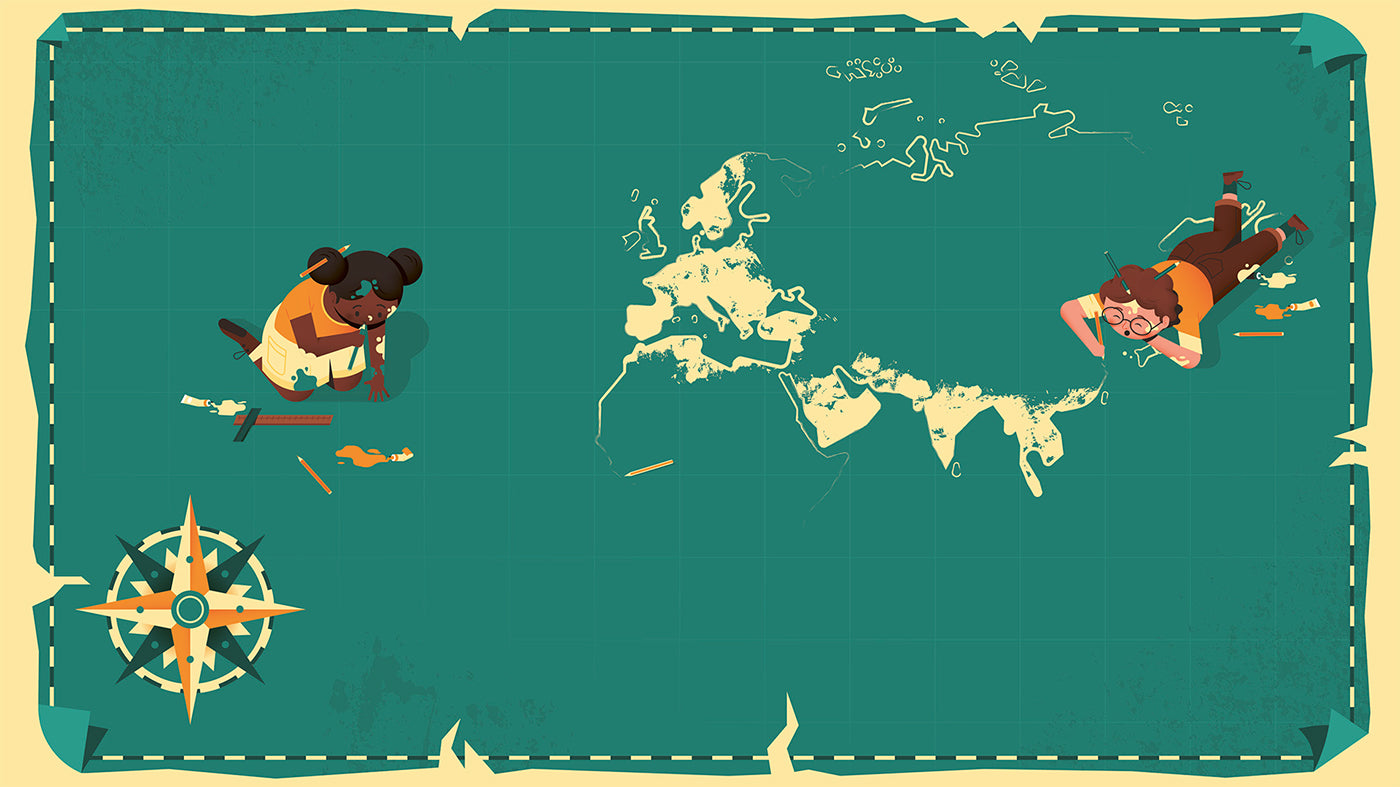
Epic Expeditions and The Explorers That Made Them
Anton Hallmann on publishing his first Little Gestalten children's book
In history, especially when documenting expeditions, certain stories are portrayed as the achievement of one lone wolf and airbrushes the endeavors of the wider group involved. German illustrator Anton Hallmann explains that particular topics and tales were "glazed" over, often with the native or minority voice being lost along the way. His first published book, Explore The World, beautifully depicts the curiosity of adventure and sets out to modernize certain historical narratives.
Brandenburg-born and Stockholm-based, Hallmann’s style artistically studies the human figure in motion and uses bright colors to bring his sceneries alive. An admirer of early 20th-century illustrators like Vladimir Lebedev, he is an artist mesmerized by graphic traditions and has an appetite for creating rousing scenery. Editorially, he has worked for Die Zeit, Süddeutsche Zeitung, and Google—but his true passion lies in the history of illustration and documenting the figurative artists who sketched themselves into the history books.

Journey through the expeditions that changed the course of history and meet the individuals that helped make that adventure a reality. This children's book delves into historical events in-depth and explores all the individuals involved who sometimes get forgotten in the history books. (Illustration: Anton Hallmann, Explore The World)
Ahead of the Little Gestalten release, Hallmann talks us through his design processes, publishing his first book, and launching a podcast series dedicated to the evolution of illustration.
What originally made you fall in love with illustration, and what is it about the art that keeps you inspired today?
I liked to draw as a child and watch cartoons all day, but which kid didn't? But it wasn't until I was older, maybe around 16 years old, when some friends and I started a music fanzine and discovered a passion. The main aim was to interview some bands we loved and get free concert tickets, but I slowly started to fall in love with doing collages for each article. Around the same time, I fell in love with literature, especially Russian literature from the early 1920s. They always worked together with illustrators and painters and I was blown away by the simple shaped illustrations like those of El Lissitzky or Vladimir Lebedev that supported the texts. And this is what still keeps me inspired. A friend of mine always refers to himself as a "problem-solver," and I like that because with my editorial work I'm always trying to solve problems like how to illustrate "big data" or make a hard and dry subject fun.
Explore the World is your first children’s book, and as someone that relishes illustrating people and figures, this project must have felt like a great fit. What was it like working on the book and how do you feel about the accomplishment?
Oh yes, it was great fun. It started during my Master's degree project and my main aim was to illustrate people in various adventurous areas. And that was an easy task. The problematic part was the tension between the achievements and the price those involved had to pay, sometimes with their lives. For example, portraying some explorers who achieved great things, but were not very kind at times. It was difficult to read about some situations, but on the other hand, inspiring too. For example, how many stories, especially of natives, haven't been told properly yet due to historic writing back then which glazed over the topic. I like the balance the book now has between familiar explorers like James Cook, and new ones, like his helper Tupaia. Especially to show that there was always teamwork and friendship in these stories. And betrayal too! I am grateful that I could illustrate it, but also for the knowledge exchange. In this case with Little Gestalten, all the feedback and support was so helpful to achieve and accomplish the vision I had of the book. So what applies to the explorers is that they needed help, which also applies to me with this book.
What is the story behind Louis and Emma, the main characters that guide readers from page-to-page? How did you conceive them and what processes did you go through to create the pair?
In the beginning, I thought that it would be nice to feature two figures who guide you through the book. But while working on it, I dismissed it and sketched it out without additional figures. But it felt a bit loose and lousy. So we came up with Louis and Emma. They don’t know all the events and learn chapter-to-chapter like the reader, the aim was for them to explore together with you. Sketching the way they looked came quite naturally to me. The first test was a perfect fit. Both of them have this adventurous touch in their clothes and should appear curious, full of fun to explore.
While working on the book, what chapter did you find most insightful and exciting to illustrate?
The chapter about the Conquistadores has everything! A story of betrayal and revenge. Everything is about greed and envy and the destruction of a highly civilized world. And then there is also a hidden love story. It was a great emotional ride. As you see a hard topic, which was also not easy to depict. Perhaps the most challenging.
We enjoyed listening to the first two episodes of your podcast series 'Pictori Podcast,' especially hearing the early 18th-century history of illustration and how the definition of illustration has changed over time. What motivated you to start the series?
Thank you, I am happy you made it through them despite my sloppy English. As I said, the book was (in another form) part of my Master's degree, and for the theory essay I wrote about non-fiction children's books. This was a fun exploration. Because not many theories can be found at the moment, but the field is growing. I didn't want to stop researching after I finished the paper, so I thought I could talk about the things I read about on a podcast. I'm hoping to upload at least one episode every month. And I mentioned the Russians will be a part of a future episode, as well as the strange history of non-fiction books for children.

Anton Hallmann studied illustration at the Hamburg University of Applied Science. He is primarily working in editorial illustration for newspapers and other clients include the likes of Lufthansa and Deutsche Bahn. (Illustration: Anton Hallmann, Explore The World)
You speak about illustration once not being seen as fine art. Do you believe this is still true today? How would you describe the modern purpose of illustration?
I think it is not true any longer. In America, France, and Japan, they all value illustration very highly. The handling in Europe towards illustration also definitely changed. For example, you can now see Christoph Niemann's work in a museum. And no one would refuse William Turner's drawings in a book. Still, illustration is hard to put into a specific box. But I also have no problem seeing illustration as a design craft. I like to lift this term, to show how much value actually can lie in a drawing. For example to put another twist on a text, but illustration can also specify it. It can stand alone to attract attention to certain topics or merged with text to build a union. It tells stories and can make you smile. For me, it is pure joy and love to illustrate.
Explore The World is a journey through ancient historical achievements to space travel into the cosmos.


